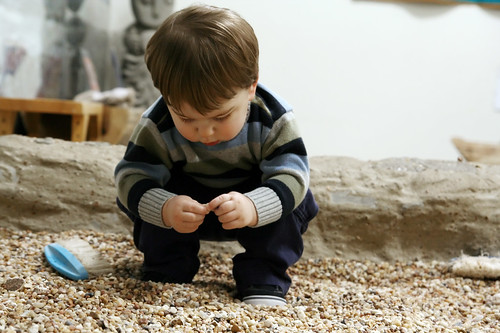In response to All They Need Is Play, Julie asks- “How to define play? I’ve always heard children learn through self-play, but I don’t know exactly what play is? Is it referring to letting my child stomp in the mud, or going to the playground? Could you please give me some examples on how to play with my child?
“Play is the answer to how anything new comes about.” Jean Piaget
Julie, What a great question! You are on the right track! Play can be letting your child stomp in a mud puddle, or climbing at the park. But even before children reach the age where they can stomp in mud puddles, they can (and do!) engage in self directed play. Here is my definition of play: Play is the way children learn about themselves, the people around them, the world they live in, and how things work in their world. Play is the way children naturally explore, and the way they gain and practice skills they will use for their whole lives. BUT play is not done to attain any reward, or end goal. Children gain pleasure from engaging in play, and this reinforces their desire to play some more.
Play is any behavior that is freely chosen, personally directed, and intrinsically motivated. What do I mean by this? Ideally, your child chooses when, with what, and how to play, and is allowed to play with as little interference or direction as possible (with consideration for the safety of self and others) for as long as possible. Maybe because she lived in Los Angeles, the movie capital of the world (or at least the United States), Magda Gerber often encouraged adults to think of a child’s play like the making of a movie, and she advised allowing the child to be the main scriptwriter, director, and actor.
“Be careful what you teach. It might interfere with what they are learning.” Magda Gerber
Play is a process of trial and error, and there is no right or wrong. Children are literally inventing the world anew when they play. Well meaning, loving adults can interfere with the process, by telling or showing a child how to play. For instance, if you teach your child how to use a paintbrush, it’s not the same as putting out the brush, and just letting her figure it out.
You might ask,”What’s wrong with showing my child how to correctly use a paintbrush?” Well, it shortcuts her exploration thus limiting her creativity, and if she is often shown how to play ‘correctly’ it may eventually erode her trust in herself, her desire to be an active explorer, and her willingness and ability to work things out by herself. Children quickly come to look to adults to show them or tell them the right way to play and even to do it for them.
Here’s an example: Playdough is a material that offers an endless number of possibilities for discovery and creation. If you hand a two and a half year old a container of playdough and nothing else, and you sit back and watch, he will happily play with it for a long time, poking, twisting, rolling, pounding, etc. Eventually, after having the opportunity to explore the dough in this way over the course of many weeks or months, he will begin to make things with the dough. But if you jump in and start showing him how to make play dough animals, he’ll quickly lose interest in his own exploration. Since he hasn’t reached the stage of being able to make animals by himself he will ask you to make animals for him. Now who is playing? Not your child! Can we trust children to learn from their own play if we don’t make things clear and explicit for them? I think so.
“When you teach a child something you take away forever his chance of discovering it for himself.” Jean Piaget
So what is your role as a parent or teacher of young children? The adult role is to create an environment that invites play and allows the child to explore and experiment within that environment to his heart’s content, without showing him how it’s supposed to be done. This leaves your child in control, and preserves his natural, inborn desire and ability (intrinsic motivation- from within) to play. When your child plays, he is not only learning, he is learning how to learn!
To me, there is nothing more exciting than watching a baby as she discovers for herself how something works for the very first time. What is obvious to us, is not always so obvious to a baby. For instance, one of the play objects I use in class is an empty 10 gallon water bottle with a narrow opening at the top. I place a basket of wooden pegs of varying thickness nearby. It doesn’t take long for most young toddlers to discover the pegs and experiment with dropping them into the water bottle, but figuring out how to get the pegs back out of the bottle is another thing entirely. This is a “problem’ that takes most children a long time to solve if shows them how to do it, and most children will happily explore different ways of solving the problem for long periods of time without becoming frustrated.
Play (exploring) is everything your baby does. She does it naturally. Before she even plays with toys, she is “playing” and learning when she looks at her hands, or kicks her feet. She is experimenting with and learning how her body works. Everything is so new to a baby, and so everything is an experiment to try to find out how things work. She uses all of her senses when she plays. When she begins to pick up toys and taste them, bang them, drop them, and retrieve them, she is playing. When she responds to your words by babbling, smiling, cooing, or she makes raspberries to get your attention, she is playing. As she moves, or plays with sounds, or drops and retrieves a toy, she is learning. She might repeat actions over and over with small differences.
You don’t have to hand her toys or show her what do to. You just have to provide a safe space for her to explore, and include simple objects, like balls, cups, spoons, dolls, empty containers, blocks, scarfs- toys that do nothing, so your baby can be active in discovering and creating her own understanding of the world. The very first play object we offer a baby in parent/infant classes is a cotton scarf, which we place in a peak, where a baby laying on her back can see it, and reach for it when she’s ready. This scarf is a staple of the play room from the time babies are about three months old, until they graduate from class at two years old. The babies use the scarfs in a variety of different ways as they grow. As your child moves from infancy into young toddlerhood, you can add a few more objects or elements (but choose wisely) to the play area, or vary the toys to provide different opportunities for her to explore. Sand, water, climbing toys, push and pull toys, empty boxes, and (once she’s well past putting things into her mouth) playdough, are some suggestions.

You don’t have to do anything but trust, watch, and enjoy. Watch to see what she’s interested in, what she does with the play objects you’re providing. Watch to see how her understanding of the world and the people in it changes and grows. Soon you will see her begin to initiate and engage in play with other children. At first, she will begin to notice other children more and more, and try to make contact, maybe by touching, showing, taking, or exchanging toys. She’ll then progress to playing peek-a-boo or chase. At some point, you’ll notice she starts to engage in pretend play, using a block to pretend to “talk” on the phone, drinking from a cup, or patting her babydoll to sleep. As her understanding of her world and the people and things in it grows, so does her play become ever more complex and sophisticated.
You offer the greatest gift when you allow your child to play her way, with you as a witness to her discoveries. This is what Magda Gerber called “wants nothing” time: “Most of us are used to, and conditioned to, doing something. Wants nothing time is different, more a time for taking in and waiting. We fully accept the infant’s beingness just by our own receptive beingness.” We also allow, encourage and protect a baby’s natural ability to experience joy in learning and creation, while she builds her self confidence, attention span, and more. These are the “bonuses” of self directed, or free play.
I’d love to hear your thoughts. What is your definition of play? Do you see a difference between child led or free play, and structured or adult-led play? Do you think children learn more from their own explorations or do they need adults to teach them and show them how to play, or is it both? What gets in the way of allowing your child to play freely? Finally, how many different ways can you think of to use a cotton scarf?
P.S. For more on play, Janet Lansbury’s blog can’t be beat if you are the parent or teacher (educarer) of babies and toddlers, and Teacher Tom’s blog is my top pick if you are the parent or teacher of children age two and older.
